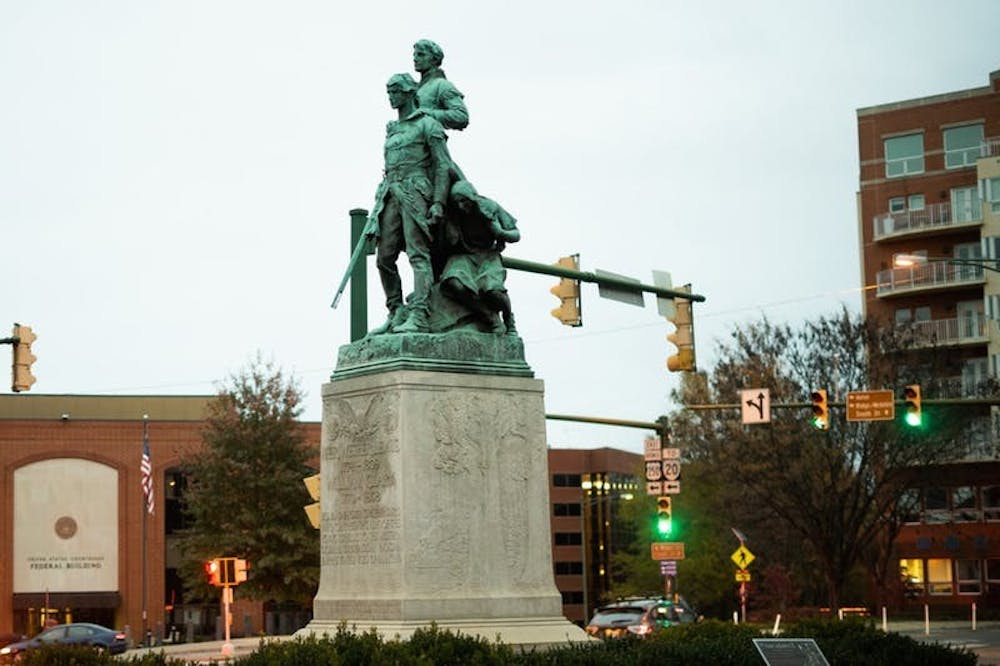This University and Charlottesville communities each have long-standing ties to slavery and white supremacy. This issue has come up recently, along with expansive local coverage on different statues and monuments in the Charlottesville area. There have been multiple reports of vandalism on the Stonewall Jackson and Robert E. Lee statues in particular. Additionally, the Charlottesville City Council just passed a resolution to work towards removing the Lewis, Clark and Sacagawea statue located on West Main Street.
At the University specifically, attempts from both students and the Administration alike have been made to highlight this racist past. The Curry School of Education and Human Development at the University recently published a website detailing the history of Jabez Lamar Monroe Curry — the namesakes of the School — and William Henry Ruffner — the building that houses it. Fliers were also posted around Grounds at the beginning of the school year highlighting the racist history of Edwin Alderman, the University’s first president and the namesake of Alderman Library.
Recently, the University has attempted to begin addressing its troublesome past, implementing a Memorial to Enslaved Workers and changing certain building names. However, the continued references to white supremacy represented by these statues and building names only demonstrate how much further the University has to go in addressing its racist past. These are not just historical monuments and names on a building — they are painful reminders of the University’s history of racism and its ties to the continued oppression of the black population in our country. As such, we should cease the celebration of the men depicted in these memorials and of the racist and discriminatory pasts that they represent.
Many people will argue that these changes represent attempts to erase the history of the country and the University. However, we need to recognize that this issue is far more complicated than that. We must ask ourselves — whose history is this? For white Americans, maybe these statues and names really do just represent the complicated history of our country and University. However, for marginalized groups — who have often lead the movements to change these memorials — they represent a history of oppression and violent persecution.
These are the names of eugenicists who fought to erase the black population, the names of slave-owners who believed that black citizens were inferior and existed solely to serve the white population. These statues depict men who ruined Native populations, forcefully taking their land and treating it as their own. This is a history that does not need to be celebrated, one which we should denounce as a disgusting part of our past. Instead, the University and Charlottesville seem to honor these men with these high statues in very public areas. We need to ask ourselves how the celebration of these men affects marginalized communities in the area.
When the City discussed the removal of the Lewis, Clark, and Sacagawea statue, they included the voices of members of different Native tribes. One such member, Rose Ann Abrahamson, a Lemhi Shoshone and descendant of Sacagawea, noted that the statue was “outwardly offensive.” These are the voices we need to be listening to when we discuss these monuments and building names. White American history is not the only history that we should care about. It is clear that the presence of these historical references are painful for many of the area’s marginalized communities, yet we continually disregard these feelings in favor of a more distorted view of American history in which these men deserve our admiration. We do not — or, rather, we should not — live in a country strictly made for white people. As such our University should care about the feelings of all of its students, recognizing how painful it is for minority students to attend a school so dedicated to the history of white supremacy.
We focus far too often on white American history in our society, often completely ignoring how this history has hurt minority communities. White history has led to the enslavement of countless people and the destruction of Native communities throughout this country. This is our past, but it does not need to be our present. These names and monuments may be considered worthy of historical preservation by some, but we have to recognize that for others they represent a dark and painful history of violence. This is a history better suited for display in our museums, as reminders of our complex past and as lessons for how we move forward into the future.
I agree that we should not erase this history — it happened, and we cannot change that. However, it also does not need to be memorialized with large monuments, seemingly serving as a form of continued intimidation of marginalized communities. As such, the movement of these monuments into museums will enable us to remember our past while still acknowledging that our society has moved forward from these men. Moving forward, we must remember that these statues and building names represent a painful history for minority communities, and we must take this into account when discussing their presence both on Grounds and in our country.
Zack Pasciak is an Opinion Columnist for The Cavalier Daily. He can be reached at opinion@cavalierdaily.com.







